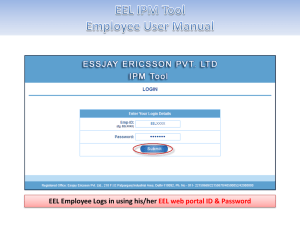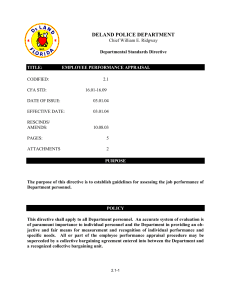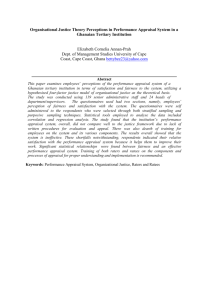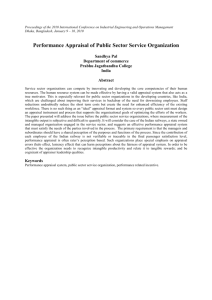Performance Appraisal : A Managerial Viewpoint
advertisement
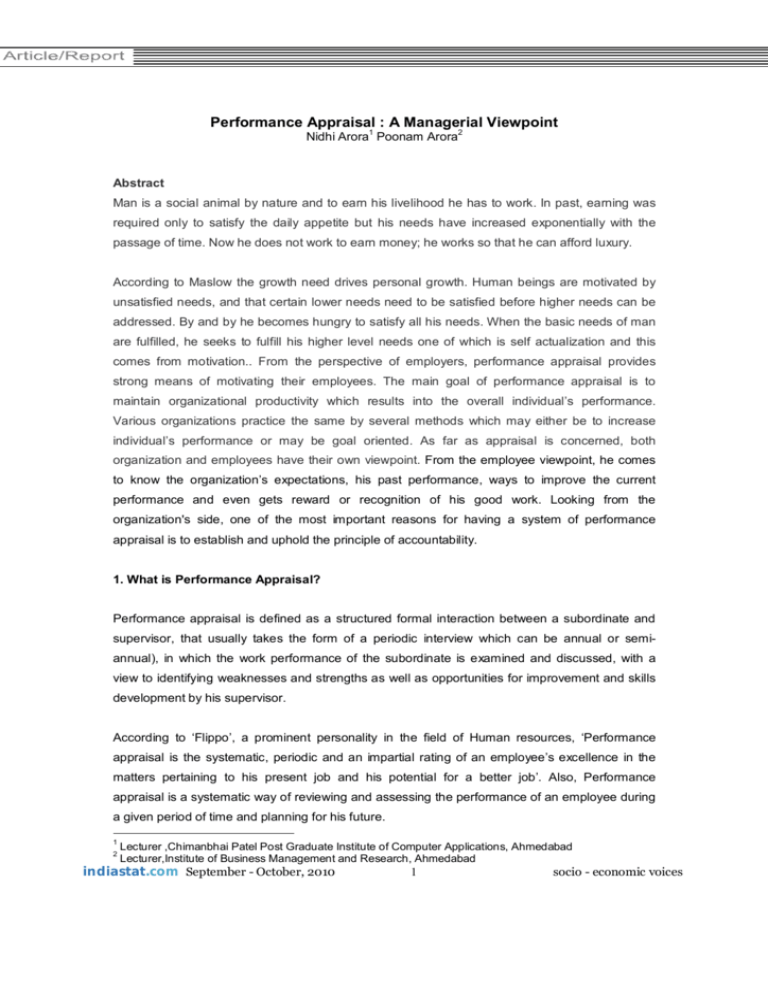
Performance Appraisal : A Managerial Viewpoint Nidhi Arora1 Poonam Arora2 Abstract Man is a social animal by nature and to earn his livelihood he has to work. In past, earning was required only to satisfy the daily appetite but his needs have increased exponentially with the passage of time. Now he does not work to earn money; he works so that he can afford luxury. According to Maslow the growth need drives personal growth. Human beings are motivated by unsatisfied needs, and that certain lower needs need to be satisfied before higher needs can be addressed. By and by he becomes hungry to satisfy all his needs. When the basic needs of man are fulfilled, he seeks to fulfill his higher level needs one of which is self actualization and this comes from motivation.. From the perspective of employers, performance appraisal provides strong means of motivating their employees. The main goal of performance appraisal is to maintain organizational productivity which results into the overall individual’s performance. Various organizations practice the same by several methods which may either be to increase individual’s performance or may be goal oriented. As far as appraisal is concerned, both organization and employees have their own viewpoint. From the employee viewpoint, he comes to know the organization’s expectations, his past performance, ways to improve the current performance and even gets reward or recognition of his good work. Looking from the organization's side, one of the most important reasons for having a system of performance appraisal is to establish and uphold the principle of accountability. 1. What is Performance Appraisal? Performance appraisal is defined as a structured formal interaction between a subordinate and supervisor, that usually takes the form of a periodic interview which can be annual or semiannual), in which the work performance of the subordinate is examined and discussed, with a view to identifying weaknesses and strengths as well as opportunities for improvement and skills development by his supervisor. According to ‘Flippo’, a prominent personality in the field of Human resources, ‘Performance appraisal is the systematic, periodic and an impartial rating of an employee’s excellence in the matters pertaining to his present job and his potential for a better job’. Also, Performance appraisal is a systematic way of reviewing and assessing the performance of an employee during a given period of time and planning for his future. 1 2 Lecturer ,Chimanbhai Patel Post Graduate Institute of Computer Applications, Ahmedabad Lecturer,Institute of Business Management and Research, Ahmedabad indiastat.com September - October, 2010 1 socio - economic voices 2. Purpose of Performance Appraisal Effective performance appraisal systems as shown in Fig.1 contain two basic operating systems in conjunction: an evaluation system and a feedback system. - The aim of the evaluation system is to identify the performance gap. This gap is the shortfall that occurs when performance does not meet the standard set by the organization as acceptable. - The aim of the feedback system is to inform the employee about the quality of his or her performance. However, the information flow is not exclusively one way. The appraisers also receive feedback from the employee about job problems, etc. 3. Steps of Conducting Employee Performance Appraisals 1. Designing a legally valid performance review process Performance appraisals should be: job-related and valid; based on a thorough analysis of the job; standardized for all employees; not biased against any race, color, sex, religion, or nationality; and performed by people who have adequate knowledge of the person or job. 2. Designing a standard form for performance appraisals The form should be standardized and it should include the name of the employee, dates specifying the time interval over which the employee is being evaluated, performance dimensions, a rating system (e.g., poor, average, good, excellent), date the performance is completed and lines for signatures of the supervisor and employee. 3. Initiating the performance review process The employer initiates the process and tells the employee of what's involved in the process. Employee updates the job description and provides written input on their own The employee provides all the information best to his knowledge but in official forms. the given format. 4. Documenting the input - referencing the job description and performance goals indiastat.com September - October, 2010 2 socio - economic voices The employer should be familiar with the job requirements and have sufficient contact with the employee so that he can make valid judgments. Major accomplishments, exhibited strengths and weaknesses according to the dimensions on the appraisal form are recorded and actions and training or development to improve the performance is suggested. 5. Holding the performance appraisal meeting The meeting's goals are discussed, action plans are made and feedback is exchanged. In the meeting, the employee speaks first and gives their input. Then employer responds and discuss different areas where he disagrees or where improvement is required. In the meeting the participation is encouraged and support is demanded. 6. Finalizing the performance appraisal form Finally all the forms are reviewed and accordingly the appraiser does the appraisal and the process comes to an end. 4. Types of Performance Appraisal Methods There are many methods that can be used for carrying out performance appraisals. Performance appraisals are used to determine a lot of things with your employer like deciding promotions, determining transfers, determining whether the employee needs training, to continue or to lay off the employee or to decide which employee should get the reward of a successful project. There are many types of performance appraisal methods, some of which are listed below: 4.1 Job Results It is not an appraisal method but job results are in themselves a source of data that can be used to appraise performance. Typically, an employee's results are compared against some objective standard of performance. This standard can be absolute or relative to the performance of others. Results indexes are often used for appraisal purposes if an employee's job has measurable results. Results indexes such as turnover, absenteeism, grievances, profitability, and production rates can be used to evaluate the performance of organization units. When such quantitative results are not available, evaluators tend to use appraisal forms based on employee behaviors and/or personal characteristics. In some cases, appraisals may focus on results rather than behaviors. This is especially true where job content is highly indiastat.com September - October, 2010 3 socio - economic voices variable, as in many managerial positions, thus making it difficult to specify appropriate behaviors for evaluative purposes. Disadvantages: Employee results are compared to some standard (which is not fixed). When result index are not available and employee characteristics, behavior and personality is taken as standards, it may result in bias. 4.2 Essay Method The essay method involves an evaluator's written report appraising an employee's performance, usually in terms of job behaviors and/or results. The subject of an essay appraisal is often justification of pay, promotion, or termination decisions, but essays can be used for developmental purposes as well. By not having to report on all job-related behaviors or results, an evaluator may simply comment on those that reflect favorably or unfavorably on an employee. Disadvantages: Since essay appraisals are to a large extent unstructured and open-ended, lack of standardization is a major problem. The open-ended, unstructured nature of the essay appraisal makes it highly susceptible to evaluator bias, which may in some cases be discriminatory. This does not usually represent a true picture of the employee or the job, and content validity of the method suffers. 4.3 Ranking Ranking methods compare one employee to another, resulting in an ordering of employees in relation to one another. Rankings often result in overall assessments of employees, rather than in specific judgments about a number of job components. Straight ranking requires an evaluator to order a group of employees from best to worst overall or from most effective to least effective in terms of a certain criterion. Alternative ranking makes the same demand, but the ranking process must be done in a specified manner (for example, by first selecting the best employee in a group, then the worst, then the second-best, then the second-worst, etc.). Disadvantages: Comparative evaluation systems such as ranking are rarely popular. No matter how close a group of employees is in the level of their performance, and no matter how well they perform on the job, some will rank high and some will end up at the bottom. Evaluators are often reluctant to make such discriminations. Also, rankings are unable to compare employees across different groups. For example, it is difficult to say whether the indiastat.com September - October, 2010 4 socio - economic voices second-ranked employee in unit A is as good as or better than the second-ranked employee in unit B. Despite the problems of ranking methods, if an organization has a very limited number of promotions or dollars to allocate, rankings can be very useful in differentiating among employees. 4.4 Forced Distribution Forced distribution is a form of comparative evaluation in which an evaluator rates subordinates according to a specified distribution. Unlike ranking methods, forced distribution is frequently applied to several rather than only one component of job performance. Use of the forced distribution method is demonstrated by a manager who is told that he or she must rate subordinates according to the following distribution: 10 percent low; 20 percent below average; 40 percent average; 20 percent above average; and 10 percent high. In a group of 20 employees, two would have to be placed in the low category, four in the below-average category, eight in the average, four above average, and two would be placed in the highest category. The proportions of forced distribution can vary. For example, a supervisor could be required to place employees into top, middle, and bottom thirds of a distribution. Disadvantages: Forced distribution is primarily used to eliminate rating errors such as leniency and central tendency, but the method itself can cause rating errors because it forces discriminations between employees even where job performance is quite similar. For example, even if all employees in a unit are doing a good job, the forced distribution approach dictates that a certain number be placed at the bottom of a graded continuum. For this reason, raters and rates do not readily accept this method, especially in small groups or when group members are all of high ability. 4.5 Graphic Rating Graphic rating scales are one of the most common methods of performance appraisal. Graphic rating scales require an evaluator to indicate on a scale the degree to which an employee demonstrates a particular trait, behavior, or performance result. Rating forms are composed of a number of scales, each relating to a certain job or performance-related dimension, such as job knowledge, responsibility, or quality of work. Each scale is a continuum of scale points, or anchors, which range from high to low, from good to poor, from indiastat.com September - October, 2010 5 socio - economic voices most to least effective, and so forth. Scales typically have from five to seven points, though they can have more or less. Graphic rating scales may or may not define their scale points. Carefully constructed graphic rating scales have a number of advantages: 1. Standardization of content permitting comparison of employees. 2. Ease of development use and relatively low development and usage cost. 3. Reasonably high rater and ratee acceptance. Disadvantages: A disadvantage of such rating scales is that they are susceptible to rating errors, which result in inaccurate appraisals. Possible rating errors include halo effect, central tendency, severity, and leniency. The halo effect occurs when a rating on one dimension of an appraisal instrument substantially influences the ratings on other dimensions for the same employee. As a result of the halo effect, an employee is rated about the same across all performance dimensions. Central tendency is a lack of variation or difference among ratings of different subordinates, wherein most employees tend to be rated as average. Leniency refers to an evaluator's tendency to rate most employees very highly across performance dimensions, whereas severity refers to the tendency to rate most employees quite harshly. 4.6 Mixed Standard Scales Mixed standard scales are a relatively recent innovation in rating scales. They contain statements representing good, average, and poor performance based on behavioral examples obtained from knowledgeable persons, usually supervisors. An evaluator's task is to indicate whether an employee either fits the statement, is better than the statement, or worse than the statement. In a mixed standard scale, each performance dimension has three statements relating to it: one illustrating good performance, one average, and one poor. Thus, this mixed standard scale has nine statements, three for each of the three dimensions used. Statements in mixed standard scales are randomly mixed, tending to reduce rater errors by making it less obvious which statements reflect effective or ineffective performance. 4.7 Behavioral Checklist indiastat.com September - October, 2010 6 socio - economic voices A behavioral checklist is a rating form containing statements describing both effective and ineffective job behaviors. These behaviors relate to a number of behavioral dimensions determined to be relevant to the job. Behavioral checklists are well suited to employee development because they focus on behaviors and results, and use absolute rather comparative standards. An advantage of behavioral checklists is that evaluators are asked to describe rather than evaluate a subordinate's behavior. For this reason, behavioral checklists may meet with less evaluator resistance than some other methods. Disadvantages: An obvious disadvantage of behavioral checklists is that much time and money must be invested to construct the instrument. 4.8 BARS - Behaviorally Anchored Rating Scales Behaviorally anchored rating scales (BARS) are rating scales whose scale points are defined by statements of effective and ineffective behaviors. They are said to be behaviorally anchored in that the scales represent a continuum of descriptive statements of behaviors ranging from least to most effective. An evaluator must indicate which behavior on each scale best describes an employee's performance. BARS differ from other rating scales in that scale points are specifically defined behaviors. Also, BARS are constructed by the evaluators who will use them. There are four steps in the BARS construction process: 1. Listing of all the important dimensions of performance for a job or jobs. 2. Collection of critical incidents of effective and ineffective behavior. 3. Classification of effective and ineffective behaviors to appropriate performance dimensions. 4. Assignment of numerical values to each behavior within each dimension. Disadvantages: As BARS is constructed by evaluators dimension of performance is decided by them. So, the dimension may differ from person to person and becomes subjective and same is the case with scaling of efficient and inefficient behavior. 4.9 Management by Objectives Management by objectives (MBO) involves setting specific measurable goals with each employee and then periodically discussing his/her progress toward these goals. The term indiastat.com September - October, 2010 7 socio - economic voices MBO almost always refers to a comprehensive organization-wide goal setting and appraisal program that consist of six main steps: 1. The organizational goals are set and organization-wide plan for next year is established. 2. Departmental goals are set. Here department heads and their superiors jointly set goals for their departments 3. Departmental goals are discussed and allocated. Department heads discuss the department's goals with all subordinates in the department and ask them to develop their own individual goals; in other words, how can each employee contribute to the department attaining its goals? 4. Expected results and individual goals are defined. Here, department heads and their subordinates set short-term performance targets. 5. Performance review and results are measured. Department heads compare actual performance for each employee with expected results. 6. In the end feedback is provided. Department heads hold periodic performance review meetings with subordinates to discuss and evaluate progress in achieving expected results. 5. Problems in Performance Appraisal The problem with the current appraisal system is not the appraisal itself but the subjectivity and lack of transparency in the system. As with most organizations objectivity and transparency is key to acceptance of the appraisal system, but these elements are not present in most organizations. Some of the problems and challenges faced by the system are: 5.1 Poor Appraisal Forms One of the main aspects of performance appraisal process is when an employee fills an appraiser form. But the form itself may contain certain errors. The appraisal process might also be influenced by the following factors relating to the forms that are used by raters: - The rating scale may be quite vague and unclear - The rating form may ignore important aspects of job performance. indiastat.com September - October, 2010 8 socio - economic voices - The rating form may contain additional, irrelevant performance dimensions. - The forms may be too long and complex. 5.2 Lack of Rater Preparedness Top management should choose the raters or the evaluators carefully. They should not have lack of competence. They should have the required expertise and the knowledge to decide the criteria accurately. They should have the experience and the necessary training to carry out the appraisal process objectively. The raters may not be adequately trained to carry out performance management activities. This becomes a serious limitation when the technical competence of a ratee is going to be evaluated by a rater who has limited functional specialization in that area. The raters may not have sufficient time to carry out appraisals systematically and conduct thorough feedback sessions. Sometimes the raters may not be competent to do the evaluations owing to a poor self-image and lack of self-confidence. They may also get confused when the objectives of appraisal are somewhat vague and unclear. 5.3 Judgment Errors Many errors based on the personal bias like stereotyping, halo effect (i.e. one trait influencing the evaluator’s rating for all other traits) etc. may creep in the appraisal process. Therefore the rater should exercise objectivity and fairness in evaluating and rating the performance of the employees. Errors may occur in rating and evaluation. People commit mistakes while evaluating people and their performance. Biases and judgment errors of various kinds spoil the system. Bias here refers to inaccurate distortion of a measurement. These are: (i) First impressions (Primacy Effect): The appraiser’s first impressions of a candidate may color his evaluation of all subsequent behavior. In the case of negative primacy effect, the employee may seem to do nothing right; in the case of a positive primacy effect, the employee can do no wrong. (ii) Halo: The Halo error occurs when one aspect of the subordinate’s performance affects the rater’s evaluation of other performance dimensions. If a worker has few absences, his supervisor might give the worker a high rating in all other indiastat.com September - October, 2010 9 socio - economic voices areas of work. Similarly an employee might be rated high on performance simply because he had a good dress sense and comes to office punctually! (iii) Horn Effect: The rater’s bias is in the other direction, where one negative quality of the employee is being rated harshly. For example, the rate does not smile normally, so he cannot get along with people! (iv) Leniency: Depending on rater’s own mental make-up at the time of appraisal, raters may be rated very strictly or very leniently. Appraisers generally find evaluating others difficult, especially where negative ratings have to be given. A professor might hesitate to fail a candidate when all other students have cleared the examination. The Leniency error can render an appraisal system ineffective. If everyone is to be rated high, the system has not done anything to differentiate among employees. (v) Central Tendency: An alternative to the leniency effect is the central tendency, which occurs when appraisers rate all employees as average performers. For example, a professor, with a view to play it safe, might give a class grades nearly equal to B, regardless of the differences in individual performance. 5.4 Ineffective Organizational Policies and Practices If the sincere appraisal effort put in by a rater is not suitably rewarded, the motivation to do the job thoroughly finishes off. Sometimes, low ratings given by raters are viewed negatively by management - as a sign of failure on the part of rater or as an indication of employee discontent. So, most employees receive satisfactory ratings, despite poor performance. Normally, the rater’s immediate supervisor must approve the ratings. However, in actual practice, this does not happen. As a result the rater ‘goes off the hook’ and causes considerable damage to the rating process. 6. Determining the Evaluation Criteria Identification of the appraisal criteria is one of the biggest problems faced by the top management. The performance data to be considered for evaluation should be carefully selected. For the purpose of evaluation, the criteria selected should be quantifiable or measurable. 5.6 Creating a Rating Instrument indiastat.com September - October, 2010 10 socio - economic voices The purpose of the Performance appraisal process is to judge the performance of the employees rather than the employee. The focus of the system should be on the development of the employees of the organization. 5.7 Resistance The appraisal process may face resistance from the employees and the trade unions for the fear of negative ratings. Therefore, the employees should be communicated and clearly explained the purpose as well the process of appraisal. The standards should be clearly communicated and every employee should be made aware that what exactly is expected from him/her. 6. References [1] Arshia Imran, Purpose of Performance Appraisal-how and why it is an Important and Effective for Any Organization. [2] Robert Bacal, M.A, What IS The Point Of Performance Appraisal. [3] Brumback, Gary B, The Complete Guide to Performance Appraisal. [4] Jimmy Sturo, Employee Performance Appraisals. [5] M. L. Caron, Performance Appraisal Methods and some Cautionary notes (A Briefing). Fig. 1: Modules of Performance Appraisal System indiastat.com September - October, 2010 11 socio - economic voices Fig. 2: Web Based Performance Appraisal System indiastat.com September - October, 2010 12 socio - economic voices





